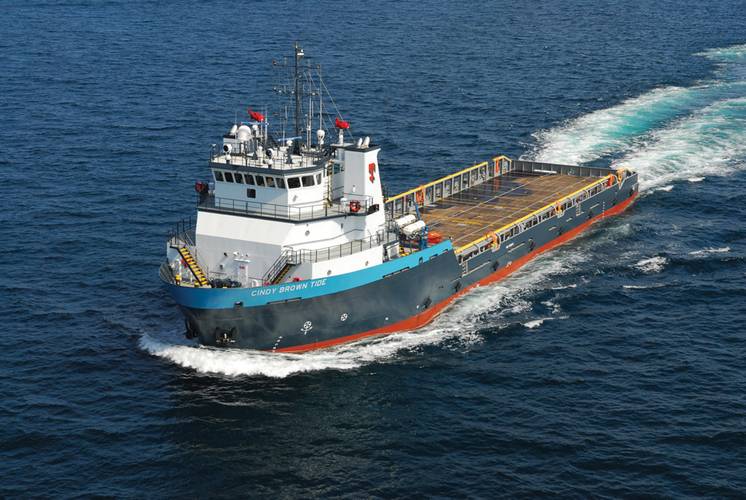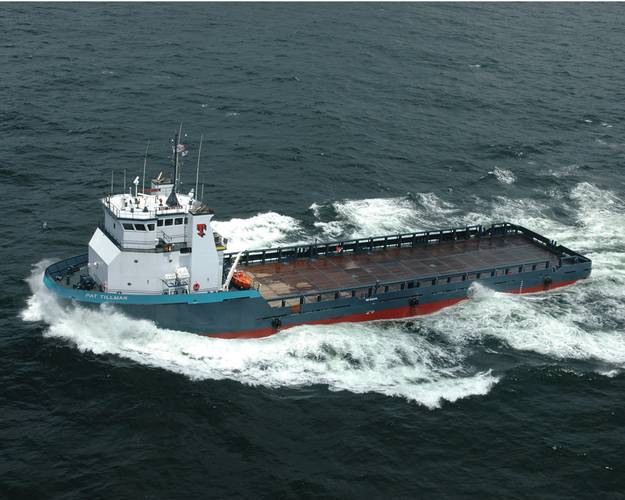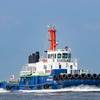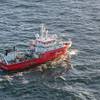Tidewater Well Positioned After Spending On Deepwater Vessels
Global demand driving consistent year-over-year profits for Tidewater. A more modern fleet riding a rising tide should continue that trend, analysts and company officials say.
Tidewater Inc., based in New Orleans, has invested in deepwater, platform supply vessels in recent years, a move that looks to be paying off as demand for those boats improves during a rush to build deep-ocean rigs. The company provides offshore supply vessels and marine support services for the world’s energy industry. Tidewater’s replacement of old with new vessels since year 2000 was worth it, recent earnings reports show. The company’s stock has languished, however, partly because of uncertainty about its joint venture in Angola in southwest Africa.
Tidewater has a new management team led by president and CEO Jeff Platt, following the retirement in May of his predecessor Dean Taylor after 34 years of service. Platt joined Tidewater in 1996. For this discussion, we interviewed Joe Bennett, Tidewater’s Executive Vice President and Chief Investor Relations Officer, along with stock analysts following the company. Bennett said last month, “we’re optimistic about deepwater for several reasons. Interest from our oil-company customers around the world in deepwater exploration and development is generally very strong. Primarily, that includes major oil companies and state-owned companies. For instance, Petrobras in Brazil is spending plenty of money both in and outside of Brazil.”
Bennett added, “Deepwater is heavily invested in, and while the last three to four years haven’t been the best in our industry, business is picking up and deepwater activity is leading the charge. Day rates for deepwater platform supply vessels have improved nicely and can continue to rise. Globally, drill ships and semi-submersibles are nearly fully utilized. In addition, about half of the 180 to 200 rigs currently under construction worldwide are for deep water. That bodes well for deepwater PSVs, the vessel of choice for those rigs.”
Tidewater: By the Numbers
The deepwater sector has been relatively active for a while, Bennett noted. Tidewater has invested over $1.8 billion in 77 deepwater PSVs as part of its expansion program since year 2000. As of June 30, 20 of 26 vessels under construction were deepwater PSVs. “At the same time, the jack-up rig count in shallow and mid water is improving globally, creating increased demand for towing supply/supply vessels, another segment of our business,” Bennett also said.
Tidewater’s vessel revenues for its first 2013 fiscal quarter, ended in June 2012, were 44% from Sub-Saharan Africa, 27% from the Americas – including about 6% from the Gulf of Mexico, 18% from Asia-Pacific and 11% from the Middle East/North Africa. In Sub-Saharan Africa, the company’s activity is concentrated in Angola, where a number of big deep water oil and gas discoveries occurred in the last four years. Tidewater’s Angolan operations have typically generated about a fourth of its vessel revenue.
Fleet Renewed Since Year 2000
In the first quarter of 2013, 91% of Tidewater’s vessel revenues and 98% of its vessel revenues less vessel operating costs were generated by boats added since the company’s fleet renewal and expansion program began in fiscal 2000, Bennett said. The company reported $0.65 in earnings per share for the first quarter, beating the consensus estimate of $0.60. Tidewater’s revenue was up 15.6% versus the same quarter a year earlier. First quarter 2013 earnings were reported on Aug. 8 and second quarter earnings will be announced on Nov. 6.
“Our new boats, built or acquired since year 2000, are providing good profits and are driving the company’s profitability,” Bennett said. “New boats have provided reasonable returns on our investments over the past few difficult years. We’re operating in an industry that is volatile, with good and bad years, and we’re currently in a cycle that’s turning around and improving. The tide is turning from a difficult market to a much better one.”
Bennett was frank about Tidewater’s performance. “We aren’t yet at the point of raving about returns on our assets, but we’re pleased with the results we’re getting given the general market environment. We’re pleased with what we have been able to do in a tough global market in recent years. We consistently recorded profits even during the bottom of the market in fiscal years 2011 and 2012. We haven’t had any years of net losses, and as the vessel market continues to improve we expect returns on our investments to likewise improve.”
In the quarter ended in June, Asian shipyards delivered three new vessels to Tidewater. Those vessels spent most of the quarter mobilizing to assignments in offshore Africa and Latin America, and were due to start generating revenue in the second fiscal quarter. Tidewater expects to take delivery of ten vessels, including seven deep water PSVs, one towing supply vessel and two crewboats, in the remaining quarters of fiscal 2013--five of which were scheduled for the quarter that ended in September.
“Our boats are mainly being built in the Far East, mostly in Chinese yards,” Bennett said. “We also have three vessels under construction in the U.S.--two in Wisconsin and one in Louisiana. Quality Shipyards is a Tidewater subsidiary in Houma, La.
“It is generally less expensive to build in the Far East than in other parts of the world,” Bennett said. “But no matter where the work is done, whether it’s China, Norway or the U.S., we have to be careful about the quality of the work being performed. We’re investing in vessels that we want to last 25 to 30 years, so it’s important to get the construction and the price right. We have to live with those decisions for several decades.”
Tidewater’s active vessel fleet stood at 258 on June 30. The average age of 217 active, new vessels built since 2000 was 5.6 years, and 41 active, older vessels averaged 27.6 years. “At the end of June, we also had 66 vessels that were stacked,“ Bennett said. “Tidewater currently stacks vessels as part of our process of disposing of older boats. When the decision is made to stack a vessel, the vessel is removed from active service and, to reduce operating costs, the crew is removed from the vessel and maintenance of the vessel is significantly reduced.”
Bennett explains, “because of reduced demand for aging equipment, we don’t expect the vast majority of our current stacked vessels to work for us again, and we put those vessels up for sale. We have been successful in selling our older equipment outside of our industry, primarily into the fishing, crabbing and shrimping industry, the Caribbean trade business or other non-oilfield-related industries.”
Bennett said “we continue to move our vessels around to global locations providing the best returns. We have a number of U.S.-flagged vessels working overseas that could be redeployed back to the GOM. Most of the demand now in the GOM is for deep water PSVs--the class of vessel that is also in high demand in other deepwater provinces of the world.”
Tidewater Renegotiates in Angola
Tidewater’s sizable presence in Angola has been bumpy recently. The company’s joint venture agreement with Angola’s state oil firm Sonangol , a partnership named Sonatide, expired on March 31 but was extended to Dec. 31 so that negotiations on restructuring the venture could continue. On Aug. 8, Tidewater CEO Jeff Platt said that Sonangol was willing to consider additional contracting activity through the Sonatide venture. Meanwhile, in the six months ended June 30, Tidewater moved five company-owned vessels from Angola to other offshore locations.
Todd Scholl, director of global oilfield research at Clarkson Capital Markets in Houston, told MarineNews last month that uncertainty about the Angola joint venture and the fact that 25 percent of Tidewater’s vessel revenues are from that nation, has kept the company’s stock price in check. Scholl said Tidewater’s French vessel competitor Bourbon SA is trying to make inroads in offshore Angola as Tidewater renegotiates its joint venture with Sonangol. “Nonetheless, Sonangol still needs Tidewater,” he insists.
Stock Analysts: Much to Like in TDW
Gregory Lewis, Credit Suisse shipping analyst, said that Tidewater still has lots of older boats in its fleet but its newer equipment generates much of the profits. He noted that “the company’s deepwater fleet represents roughly 25 percent of boats on the water but generated 45 percent of revenue in FY 2012.“
“Tidewater’s fleet renewal has absolutely helped the company transform its fleet,” Lewis said. He added “it’s important to note that Tidewater had an older fleet heading into the last upcycle. The company has generated almost $700 million in cash from vessel sales of non-core tonnage, which has translated into gains from sale of about $250 million.”
Tidewater stock (NYSE: TDW) peaked at over $65 a share in August 2007 and retreated to below $35 in March 2009. It has since recovered, however, and hovered between $47 and $48 in late September. On Sept. 18, Wells Fargo equities analysts said in a research note, “TDW is the largest, publicly traded operator of offshore service vessels in terms of fleet size, geographic footprint and market capitalization. The company is nearing completion of a 12-plus year effort to replace its 500-vessel, traditional fleet with a new, more capable fleet of 225 to 250 vessels that contains even greater revenue and earnings potential.”
Wells Fargo went on to say, “we believe this $4.1 billion fleet transformation positions TDW especially well for rising demand within the rapidly expanding, ultra-deep water drilling market.” They predicted that Tidewater’s earnings will grow, driven by 15 percent to 20 percent increases in deepwater vessel rates and by the contribution of 25 new vessels to its fleet.
On Aug. 8, TheStreet Ratings, from TheStreet Inc. in New York, upgraded Tidewater’s stock from “hold” to “buy,” based on a computer metrics program. TheStreet pointed to multiple strengths, including revenue growth which has slightly outpaced the industry average; a largely-solid financial position, with reasonable debt levels by most measures; increased net income; good cash flow from operations; and expanding profit margins. Those strengths outweigh the fact that performance of the company’s stock has been lackluster, TheStreet Ratings said.
Tidewater Buoyed by International Focus
Tidewater has hedged its bets through geographic diversification. The company started in the Gulf of Mexico in 1956, began operating in Venezuela in 1958 and by 1966 had expanded through South America and into Central America and West Africa.
Bennett said “we have management teams in many different regions around the world. Most of our competitors are regional or local, however. If the area they are in isn’t doing well, they could have a difficult time without infrastructure in other markets to redeploy their vessels to. We saw how Gulf of Mexico-based operators struggled after the Macondo incident in 2010.”
Bennett perhaps said it best when he concluded, “one of Tidewater’s real strengths is that we’ve been international, with a large overseas presence, for over 50 years.” It’s hard to argue with that, especially given the events of the past three years here in the U.S. markets. Positioned to take advantage of an energy recovery – happening here and abroad – and using a fleet that becomes, on average, more modern every day, it isn’t hard to see why analysts are bullish on TDW. And, if “all the boats float on a rising tide,” then it could also be argued that those with the largest number(s) of assets will be especially blessed. Only time will tell.
(As published in the November 2012 edition of Marine News - www.marinelink.com)




















